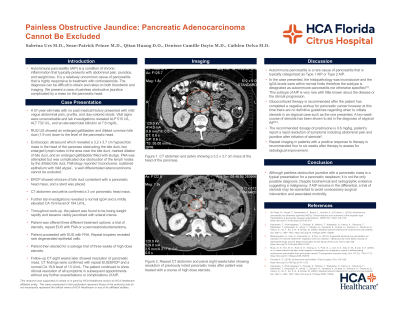Back


Poster Session A - Sunday Afternoon
Category: Biliary/Pancreas
A0079 - Painless Obstructive Jaundice: Pancreatic Adenocarcinoma Cannot Be Excluded
Sunday, October 23, 2022
5:00 PM – 7:00 PM ET
Location: Crown Ballroom

Has Audio

Sabrina R. Urs, MD
HCA Florida Citrus Hospital, FL
Presenting Author(s)
Sabrina Urs, MD1, Sean-Patrick Prince, MD, MPH2, Qitan Huang, DO1, Denisse Camille Dayto, MD1, Cathlen Delva, MD1
1HCA Florida Citrus Hospital, Inverness, FL; 2University of Miami/Holy Cross Health, Inverness, FL
Introduction: Autoimmune pancreatitis (AIP) is a chronic inflammatory condition typically presenting with abdominal pain, jaundice and weight loss. AIP is an uncommon cause of pancreatitis and diagnosis may be challenging, but it is highly responsive to corticosteroids. We present a case of painless obstructive jaundice complicated by a mass on the pancreatic head.
Case Description/Methods: A 57-year-old Indian male with no past medical history presented with vague abdominal pain, pruritus, and clay colored stools. Vital signs were unremarkable and laboratory investigations revealed alkaline phosphatase 515 U/L, alanine transaminase 732 IU/L, and total bilirubin 7.6 mg/dL.
The patient underwent a right upper quadrant ultrasound which showed an enlarged gallbladder and dilated common bile duct (1.9 cm) down to the level of the pancreatic head. An endoscopic ultrasound (EUS) revealed a 3.2 x 3.7 cm hypoechoic mass in the head of the pancreas obstructing the bile duct, two enlarged lymph nodes in the area near the bile duct, marked bile duct dilation, and an enlarged sludge-filled gallbladder. Of note, unlike most ductal tumors the pancreatic duct upstream of the mass was not dilated. Fine needle aspiration (FNA) was unsuccessful due to the obstruction by the lymph nodes. Endoscopic retrograde cholangiopancreatography (ERCP) showed stricture of bile duct consistent with a pancreatic head mass, and was stented. Abdominal and pelvic computed tomography (CT) confirmed a 3 cm pancreatic head mass. Pathology result from the attempted FNA was inconclusive.
Further labs revealed normal IgG4 and CA 19-9 level of 194; indicative of possible pancreatic malignancy. The patient developed jaundice, scleral icterus and rapid weight loss. EUS with FNA with repeat biopsies revealed rare degenerated epithelial cells. The patient was treated with high dose steroids, with planned pancreaticoduodenectomy. Follow-up CT revealed resolution of the pancreatic mass and was confirmed by repeat EUS/ERCP and normal CA 19-9 level.
Discussion: Although painless obstructive jaundice with a pancreatic mass is a typical presentation for a pancreatic neoplasm; it is not the only possible diagnosis. Despite biochemical and radiographic evidence suggesting a malignancy; if AIP remains in the differential, a trial of steroids may be warranted to avoid unnecessary surgical intervention and associated morbidity.
Disclosures:
Sabrina Urs, MD1, Sean-Patrick Prince, MD, MPH2, Qitan Huang, DO1, Denisse Camille Dayto, MD1, Cathlen Delva, MD1. A0079 - Painless Obstructive Jaundice: Pancreatic Adenocarcinoma Cannot Be Excluded, ACG 2022 Annual Scientific Meeting Abstracts. Charlotte, NC: American College of Gastroenterology.
1HCA Florida Citrus Hospital, Inverness, FL; 2University of Miami/Holy Cross Health, Inverness, FL
Introduction: Autoimmune pancreatitis (AIP) is a chronic inflammatory condition typically presenting with abdominal pain, jaundice and weight loss. AIP is an uncommon cause of pancreatitis and diagnosis may be challenging, but it is highly responsive to corticosteroids. We present a case of painless obstructive jaundice complicated by a mass on the pancreatic head.
Case Description/Methods: A 57-year-old Indian male with no past medical history presented with vague abdominal pain, pruritus, and clay colored stools. Vital signs were unremarkable and laboratory investigations revealed alkaline phosphatase 515 U/L, alanine transaminase 732 IU/L, and total bilirubin 7.6 mg/dL.
The patient underwent a right upper quadrant ultrasound which showed an enlarged gallbladder and dilated common bile duct (1.9 cm) down to the level of the pancreatic head. An endoscopic ultrasound (EUS) revealed a 3.2 x 3.7 cm hypoechoic mass in the head of the pancreas obstructing the bile duct, two enlarged lymph nodes in the area near the bile duct, marked bile duct dilation, and an enlarged sludge-filled gallbladder. Of note, unlike most ductal tumors the pancreatic duct upstream of the mass was not dilated. Fine needle aspiration (FNA) was unsuccessful due to the obstruction by the lymph nodes. Endoscopic retrograde cholangiopancreatography (ERCP) showed stricture of bile duct consistent with a pancreatic head mass, and was stented. Abdominal and pelvic computed tomography (CT) confirmed a 3 cm pancreatic head mass. Pathology result from the attempted FNA was inconclusive.
Further labs revealed normal IgG4 and CA 19-9 level of 194; indicative of possible pancreatic malignancy. The patient developed jaundice, scleral icterus and rapid weight loss. EUS with FNA with repeat biopsies revealed rare degenerated epithelial cells. The patient was treated with high dose steroids, with planned pancreaticoduodenectomy. Follow-up CT revealed resolution of the pancreatic mass and was confirmed by repeat EUS/ERCP and normal CA 19-9 level.
Discussion: Although painless obstructive jaundice with a pancreatic mass is a typical presentation for a pancreatic neoplasm; it is not the only possible diagnosis. Despite biochemical and radiographic evidence suggesting a malignancy; if AIP remains in the differential, a trial of steroids may be warranted to avoid unnecessary surgical intervention and associated morbidity.
Disclosures:
Sabrina Urs indicated no relevant financial relationships.
Sean-Patrick Prince indicated no relevant financial relationships.
Qitan Huang indicated no relevant financial relationships.
Denisse Camille Dayto indicated no relevant financial relationships.
Cathlen Delva indicated no relevant financial relationships.
Sabrina Urs, MD1, Sean-Patrick Prince, MD, MPH2, Qitan Huang, DO1, Denisse Camille Dayto, MD1, Cathlen Delva, MD1. A0079 - Painless Obstructive Jaundice: Pancreatic Adenocarcinoma Cannot Be Excluded, ACG 2022 Annual Scientific Meeting Abstracts. Charlotte, NC: American College of Gastroenterology.
